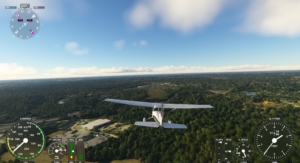Abnormal maneuvers for a student pilot to practice in a simulator
|
Getting your Trinity Audio player ready...
|
 Home flight simulators offer a wealth of practice when it comes to today’s budding aviators. No longer do we have to settle for green lines on a black background with a few instrument indications. We can turn on live weather, sync with our actual electronic flight bag, and practice communications. You could pick up a Private Pilot maneuvers guide and fill a weekend practicing maneuvers that’ll be in the queue for a checkride. Enjoy a few maneuvers below that may not be requested by an examiner but would be helpful to have an elementary understanding of.
Home flight simulators offer a wealth of practice when it comes to today’s budding aviators. No longer do we have to settle for green lines on a black background with a few instrument indications. We can turn on live weather, sync with our actual electronic flight bag, and practice communications. You could pick up a Private Pilot maneuvers guide and fill a weekend practicing maneuvers that’ll be in the queue for a checkride. Enjoy a few maneuvers below that may not be requested by an examiner but would be helpful to have an elementary understanding of.
(All outside the aircraft images are taken from Microsoft Flight Simulator and all inside the aircraft images are taken from X-Plane 12. You can fly either view in either program.)
1) Absolute Ceiling
The absolute ceiling of an aircraft is something theorized by a designer and tested by the demo pilot. Rarely is it utilized or factored into a flight for the proficient pilot. With a simulator we can test where that asymptote in the sky is for our aircraft and what it’s like when the “power available” versus “power required” performance lines intersect. For a bonus, try this maneuver with a multiengine aircraft and starve one of the engines of fuel once you’ve reached absolute ceiling.


2) Emergency Descent
This maneuver was described to me by my instructor as the appropriate move when a passenger has a medical emergency and you’re high above an airport. Enjoy a rare and counterintuitive sight picture for a pilot as you look to lose as much altitude as possible in the shortest amount of time. Be careful flirting with that VNE speed.


3) Impossible Turn
A simulator is a great (and strongly preferred) method of practicing the “Impossible Turn.” It took me a while to realize that departure can be a more risky phase of flight than approach, but I understand that now. Imagine taking off and having your engine quit 700’ feet into the climb… Do we have enough altitude to make it back to the runway or should we look for a field ahead? We can practice this scenario continuously with changes in wind speeds, direction, and airport density altitudes.


4) Stuck Full Throttle
This mechanical failure is very rare and less likely on lever-operated aircraft rather than the vernier-style of a Cessna. But it’s helpful to put yourself in the situation of “what if the engine keeps the throttle completely open regardless of my setting?” This is one of those emergencies you won’t find on a checklist but it’s worth flying a few times in a simulator to see what works for you.


5) Flying Through Icing Conditions
Flying through icing conditions in a Cessna 172 with anti-icing (only pitot heat and glareshield cabin heat) is a no go at all times. Flying through icing conditions in an aircraft with de-icing equipment (TKS fluid or pneumatic boots) is acceptable for limited time periods and likely more necessary at higher altitudes. Eventually the advancing pilot needs to transition from avoiding ice to learning how to deal with ice. Practice the earlier phase of this progression in a simulator while simultaneously testing how quickly the aerodynamics of an aircraft change with ice on the wings, prop and glareshield.


- Home Simulator Flying and Flight Training - May 30, 2024
- What rusty pilots should know about home simulators - September 21, 2023
- My experience as a rusty pilot - September 14, 2023

